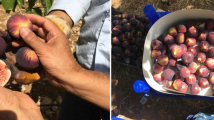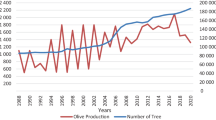Abstract
The purpose of this study is to evaluate the energy balance of organic olive production in Aydın-Karpuzlu Region in Turkey in 2015. In order to evaluate the energy input-output of organic olive, data has been provided by Aydın-Karpuzlu Organic Olive Producers Association. The agricultural input energies and output energies used in organic olive production have been calculated to evaluation the energy inputs and energy output. According to the research findings, the energy inputs in organic olive production have been calculated respectively as 19,426.95 MJ ha−1 (50.31%) diesel fuel energy, 12,960 MJ ha−1 (33.56%) machinery energy, polyethylene trap energy 3520 MJ ha−1 (9.12%), 2116.80 MJ ha−1 (5.48%) human labour energy, 276.48 MJ ha−1 (0.72%) electricity energy, 231.60 MJ ha−1 (0.60%) organic chemical energy and 81.87 MJ ha−1 (0.21%) transportation energy. Total input energy has been calculated as 38,613.70 MJ ha−1. Total output energy have been calculated as 104,888.78 MJ ha−1. The energy output/input ratio, specific energy, energy productivity and net energy calculations have been calculated respectively as 2.72, 4.34 MJ kg−1, 0.23 kg MJ−1 and 66,275.08 MJ ha−1 in organic olive production.
Similar content being viewed by others
References
Acaroğlu M (2004) Miscanthus X Giganteus’un orta Anadolu-Konya şartlarında yetiştirilmesi ve enerji bilançosunun belirlenmesi. II. Ulusal Ege Enerji Sempozyumu ve Sergisi, Dumlupınar Üniversitesi, Kütahya, pp 358–362 (in Turkish)
Akçaöz H (2011) Analysis of energy use for banana production: a case study from Turkey. Afr J Agric Res 6(25):5618–5624
Anonymous (2014) Aydın organik ve iyi tarim yol haritasi raporu. T.C. Güney Ege Kalkınma Ajansı, Türkiye
Anonymous (2016a) Aydın-Karpuzlu Organic Olive Producers Association. Karpuzlu-Aydın, Turkey
Anonymous (2016b) Türkiye Cumhuriyeti Karpuzlu Kaymakamlığı. http://www.karpuzlu.gov.tr/default_B0.aspx?content=367. Accessed 17 Sept 2016
Arthurson V, Jäderlund L (2011) Utilization of natural farm resources for promoting high energy efficiency in low-input organic farming. Energies 4:804–817
Asakereh A, Shiekhdavoodi MJ, Almassi M, Sami M (2010) Effects of mechanization on energy requirements for apple production in Esfahan province, Iran. Afr J Agric Res 5(12):1424–1429
Atılgan A, Köknaroğlu H (2006) Cultural energy analysis on broilers reared in different capaticty poultry houses. Ital J Anim Sci 5:393–400
Azizi A, Heidari S (2013) A comparative study on energy balance and economical indices in irrigated and dry land barley production systems. Int J Environ Sci Technol (Tehran) 10:1019–1028
Baran MF (2016) Energy efficiency analysis of cotton production in Turkey: a case study for Adıyaman province. Am J Agric Environ Sci 16(2):229–233
Baran MF, Gökdoğan O (2016) Determination of energy of sugar beet production in Turkey: a case study of Kırklareli Province. Energy Effic 9(2):487–494
Baran MF, Lüle F, Gökdoğan O (2017a) Energy input-output analysis of organic grape production: a case study from Adiyaman Province. Erwerbs-Obstbau. doi:10.1007/s10341-017-0322-1
Baran MF, Gökdoğan O, Oğuz H I (2017b) Determining the energy usage efficiency of walnut (Juglans regia L.) cultivation in Turkey. Erwerbs-Obstbau 59:77–82. doi:10.1007/s10341-016-0301-y
Barut ZB, Ertekin C, Karaağaç HA (2011) Tillage effects on energy use for corn silage in Mediterranean Coastal of Turkey. Energy 36:5466–5475
Bilalis D, Kamariari P‑E, Karkanis A, Efthimiadou A, Zorpas A, Kakabouki I (2013) Energy inputs, output and productivity in organic and conventional maize and tomato production, under Mediterranean Conditions. Not Bot Horti Agrobot 41(1):190–194
Bilgili ME (2012) Limon üretiminde enerji kullanım etkinliğinin belirlenmesi; Adana ili örneği. Tarım Makinaları Bilimi Dergisi 8(2):199–203 (in Turkish)
Çanakçı M (2010) Energy use pattern and economic analyses of pomegranate cultivation in Turkey. Afr J Agric Res 5(7):491–499
Çelik Y, Peker K, Oğuz C (2010) Comparative analysis of energy efficiency in organic and conventional gardening systems: A case study of black carrot (Daucus carota L.) production in Turkey. Philipp Agric Sci 93(2):224–231
Dalgaard T, Halberg N, Porter JR (2001) A model for fossil energy use in Danish agriculture used to compare organic and conventional farming. Agric Ecosyst Environ 87(1):51–65
Demircan V, Ekinci K, Keener HM, Akbolat D, Ekinci C (2006) Energy and economic analysis of sweet cherry production in Turkey: A case study from Isparta province. Energy Convers Manag 47:1761–1769
Demircan V, Köknaroğlu H (2007) Effect of farm size on sustainability of beef cattle production. J Sustain Agric 31(1):75–87
Esengün K, Gündüz O, Erdal G, Erdal H (2007) An economic analysis and energy use in stake-tomato production in Tokat province of Turkey. Renew Energy 32:1873–1881
Fredriksson H, Baky A, Bernesson S, Nordberg A, Noren O, Hansson PA (2006) Use of on-farm produced biofuels on organic farms-evaluation of energy balances and environmental loads for three possible fuels. Agric Syst 89:184–203
Gezer I, Acaroğlu M, Hacıseferoğulları H (2003) Use of energy and labor in apricot agriculture in Turkey. Biomass Bioenergy 24:215–219
Gokdogan O, Oguz HI, Baran MF (2017) Energy input-output analysis in organic mulberry (Morus spp.) production in Turkey: a case study Adiyaman-Tut Region. Erwerbs-Obstbau. doi:10.1007/s10341-017-0333-y
Göktolga ZG, Gözener B, Karkacıer O (2006) Şeftali üretiminde enerji kullanımı: Tokat ili örneği. Gaziosmanpaşa Üniversitesi Ziraat Fakültesi Dergisi 23(2):39–44 (in Turkish)
Grandi C (2008) Organic agriculture enhances agrobiodiversity. Biodiversity 9:33–35
Green MB (1987) Energy in pesticide manufacture, distribution and use. In: Helsel ZR (ed) Energy in plant nutrition and pest control. Energy in World Agriculture, vol 2. Elsevier, Amsterdam, pp 165–177
Guzman GI, Alonso AM (2008) A comparison of energy use in conventional and organic olive oil production in Spain. Agric Syst 98:167–176
Gündoğmuş E (2006) Energy use on organic farming: a comparative analysis on organic versus conventional apricot production on small holdings in Turkey. Energy Convers Manag 47:3351–3359
Heywood VH (1978) Flowering plants of the World. Oxford University Press, Oxford London Melbourne
Işık A, Sabancı A (1991) A research on determining basic management data and developing optimum selection models of farm machinery and power for the mechanization planning in the irrigated farming of the Çukurova region. Turk J Agric For 15:899–920
Karaağaç MA, Aykanat S, Çakır B, Eren O, Turgut MM, Barut ZB, Öztürk HH (2011) Energy balance of wheat and maize crops production in Hacıali undertaking. 11th International Congress on Mechanization and Energy in Agriculture Congress, Istanbul, 21–23 September 2011, pp 388–391
Kızılaslan H (2009) Input-output energy analysis of cherries production in Tokat province of Turkey. Appl Energy 86:1354–1358
Klimekova M, Lehocka Z (2007) Comparison of organic and conventional farming system in term of energy efficiency. http://orgprints.org/view/projects/wissenschaftstagung-2007.html. Accessed 9 Mar 2011
Koçtürk OM, Engindeniz S (2009) Energy and cost analysis of sultana grape growing: a case study of Manisa, west Turkey. Afi J Agric Res 4(10):938–943
Köknaroğlu H, Ali A, Ekinci K, Morrical DG, Hoffman MP (2007) Cultural energy analysis of lamb production in the feedlot or on pasture and in the feedlot. J Sustain Agric 30(4):95–108
Mani I, Kumar P, Panwar JS, Kant K (2007) Variation in energy consumption in production of wheat-maize with varying altitudes in hill regions of Himachal Prades, India. Energy 32:2336–2339
Mandal KG, Saha KP, Ghosh PK, Hati KM, Bandyopadhyay KK (2002) Bioenergy and economic analysis of soybean based crop production systems in central India. Biomass Bioenergy 23:337–345
Marakoğlu T, Çarman K (2010) Energy balance of direct seeding applications used in wheat production in middle Anatolia. Afr J Agric Res 5(10):988–992
Mirzaee E, Omid M, Asakereh A, Safaieenejad M, Dalvand MJ (2011) 11th Energy efficiency in organic lentil production in Lorestan Province of Iran. International Congress on Mechanization and Energy in Agriculture Congress, Istanbul, 21–23 September 2011, pp 383–387
Mohammadi A, Tabatabaeefar A, Shahin S, Rafiee S, Keyhani A (2008) Energy use and economical analysis of potato production in Iran a case study: Ardabil province. Energy Convers Manag 49:3566–3570
Mohammadi A, Omid M (2010) Economical analysis and relation between energy inputs and yield of greenhouse cucumber production in Iran. Appl Energy 87:191–196
Mohammadi A, Rafiee S, Mohtasebi SS, Rafiee H (2010) Energy inputs-yield relationship and cost analysis of kiwifruit production in Iran. Renew Energy 35:1071–1075
Olgun A, Artukoğlu MM, Adanacıoğlu H (2008) Konvansiyonel zeytin üreticilerinin organik zeytin üretimine geçme konusundaki eğilimleri üzerine bir araştırma. Ege Üniversitesi Ziraat Fakültesi Dergisi 45(2):95–101 (in Turkish)
Özkan B, Akcaoz H, Karadeniz F (2004a) Energy requirement and economic analysis of citrus production in Turkey. Energy Convers Manag 45:1821–1830
Özkan B, Kürklü A, Akçaöz H (2004b) An input-output energy analysis in greenhouse vegetable production: a case study for Antalya region of Turkey. Biomass Bioenergy 26:89–95
Özkan B, Akçaöz H, Fert C (2004c) Energy input-output analysis in Turkish agriculture. Renew Energy 29:39–51
Özkan B, Fert C, Karadeniz CF (2007) Energy and cost analysis for greenhouse and open-field grape production. Energy 32:1500–1504
Özkaya MT, Tunalıoğlu R, Özkaya FD, Ulaş M (2015) Zeytin üretiminde değişimler ve yeni arayışlar, TMMOB Ziraat Mühendisleri Odası. Ziraat Mühendisliği VIII. Teknik Kongresi, Ankara, 12–16 Ocak 2015, pp 630–644
Öztürk HH, Ekinci K, Barut ZB (2006) Energy analysis of the tillage systems in second crop corn production. J Sustain Agric 28(3):25–37
Öztürk F, Yalçın M, Dıraman H (2009) Türkiye Zeytinyağı ekonomisine genel bir bakış. Gıda Teknolojileri Elektronik Dergisi 4(2):35–51 (in Turkish)
Pimentel D (1992) Energy inputs in production agriculture. In: Fluck RC (ed) Energy in farm production energy in world agriculture, vol 6. Elsevier, Amsterdam, pp 13–29
Pimentel D (1993) Economics and energetics of organic and conventional farming. J Agric Environ Ethics 6(1):53–60
Pimentel D, Hepperly P, Hanson J, Seidel R, Douds D (2005) Environmental, energetic, and economic comparisons of organic and conventional farming systems. Bioscience 55:573–582
Pishgar-Komleh SH, Sefeedpari P, Rafiee S (2011) Energy and economic analysis of rice production under different farm levels in Gulian province of Iran. Energy 36:5824–5831
Samavatean N, Rafiee S, Mobli H, Mohammadi A (2011) An analysis of energy use and relation between energy inputs and yield, costs and income of garlic production in Iran. Renew Energy 36:1808–1813
Santucci FM (2007) Organic olive oil. DSEEA UniPG, Washington DC
Sandhu HS, Wratten SD, Cullen R (2010) Organic agriculture and ecosystem services. Environ Sci Policy 13:1–7
Singh JM (2002) On garden energy use pattern in different cropping systems in Haryana, India. International Institute of Management University of Flensburg, Germany (Sustainable Energy Systems and Management. Master of Science)
TÜİK (2016) Türkiye İstatistik Kurumu Bitkisel Üretim İstatistikleri 2013 Verileri. http://tuikapp.tuik.gov.tr/bitkiselapp/bitkisel.zul. Accessed 17 Sept 2016
Uyguç A (1998) Dünden bugüne Karpuzlu. Aydın Güneş Matbaası, Türkiye (in Turkish)
Yılmaz I, Özalp A, Aydoğmuş F (2010) Antalya ili bodur elma üretiminde enerji kullanım etkinliğinin belirlenmesi: Elmalı ilçesi örneği. Akdeniz Üniversitesi Ziraat Fakültesi Dergisi 23(2):93–97 (in Turkish)
Acknowledgements
We thanks to Aydın-Karpuzlu Organic Olive Producers Association for help in study.
Author information
Authors and Affiliations
Corresponding author
Ethics declarations
Conflict of interest
O. Gökdoğan and O. Erdoğan declare that they have no competing interests.
Rights and permissions
About this article
Cite this article
Gökdoğan, O., Erdoğan, O. Evaluation of Energy Balance in Organic Olive (Olea Europaea L.) Production in Turkey. Erwerbs-Obstbau 60, 47–52 (2018). https://doi.org/10.1007/s10341-017-0338-6
Received:
Accepted:
Published:
Issue Date:
DOI: https://doi.org/10.1007/s10341-017-0338-6




